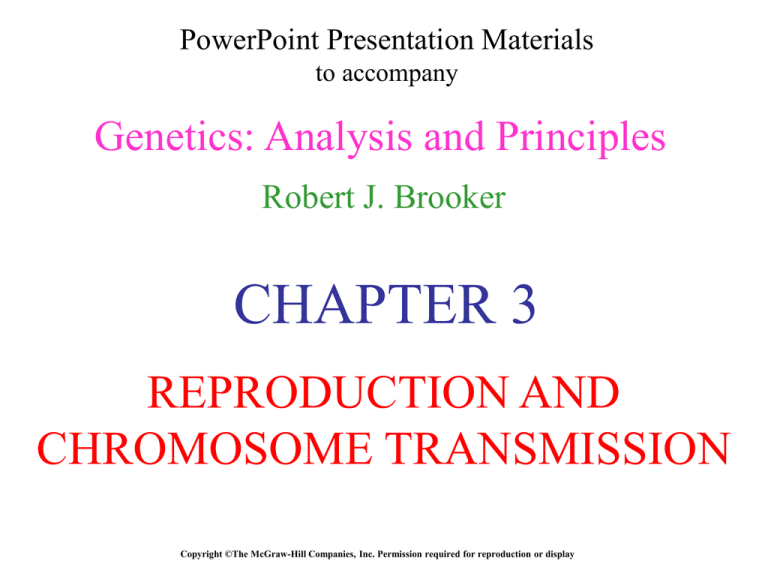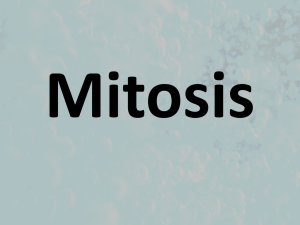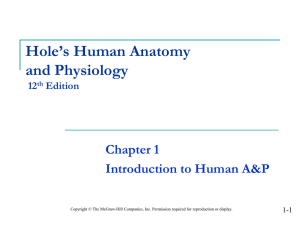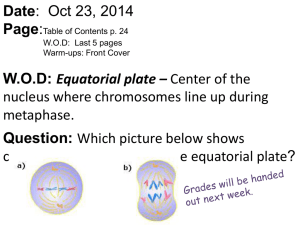
PowerPoint Presentation Materials
to accompany
Genetics: Analysis and Principles
Robert J. Brooker
CHAPTER 3
REPRODUCTION AND
CHROMOSOME TRANSMISSION
Copyright ©The McGraw-Hill Companies, Inc. Permission required for reproduction or display
The physical location of a gene on a
chromosome is called its locus.
Figure 3.3
3-17
MITOSIS
Cell division in prokaryotes requires a
replication and sorting process that is more
complicated than simple binary fission
Eukaryotic cells that are destined to divide
progress through a series of stages known as
the cell cycle
Refer to Figure 3.5
Copyright ©The McGraw-Hill Companies, Inc. Permission required for reproduction or display
3-23
Figure 3.5
Synthesis
Gap 1
Gap 2
3-24
MITOSIS
In actively dividing cells, G1, S and G2 are
collectively know as interphase
A cell may remain for long periods of time in
the G0 phase
A cell in this phase has
Either postponed making a decision to divide
Or made the decision to never divide again
Terminally differentiated cells (e.g. nerve cells)
Copyright ©The McGraw-Hill Companies, Inc. Permission required for reproduction or display
3-25
MITOSIS
During the G1 phase, a cell prepares to divide
The cell reaches a restriction point and is
committed on a pathway to cell division
Then the cell advances to the S phase, where
chromosomes are replicated
The two copies of a replicated chromosome are
termed chromatids
They are joined at the centromere to form a pair of
sister chromatids
Copyright ©The McGraw-Hill Companies, Inc. Permission required for reproduction or display
3-26
Figure 3.6 (b)
Copyright ©The McGraw-Hill Companies, Inc. Permission required for reproduction or display
3-27
Note that at the end of S phase, a cell has
twice as many chromatids as there are
chromosomes in the G1 phase
A human cell for example has
46 distinct chromosomes in G1 phase
46 pairs of sister chromatids in S phase
Therefore the term chromosome is relative
In G1 and late in the M phase, it refers to the
equivalent of one chromatid
In G2 and early in the M phase, it refers to a pair
of sister chromatids
Copyright ©The McGraw-Hill Companies, Inc. Permission required for reproduction or display
3-28
During the G2 phase, the cell accumulates the
materials that are necessary for nuclear and cell
division
It then progresses into the M phase of the cycle
where mitosis occurs
The primary purpose of mitosis is to distribute the
replicated chromosomes to the two daughter cells
In humans for example,
The 46 pairs of sister chromatids are separated and
sorted
Each daughter cell thus receives 46 chromosomes
Copyright ©The McGraw-Hill Companies, Inc. Permission required for reproduction or display
3-29
Mitosis was first observed microscopically in
the 1870s by the German biologist, Walter
Flemming
He coined the term mitosis
From the Greek mitos, meaning thread
The process of mitosis is shown in Figure 3.7
The original mother cell is diploid (2n)
It contains a total of six chromosomes
Three per set (n = 3)
One set is shown in blue and the homologous set in red
Copyright ©The McGraw-Hill Companies, Inc. Permission required for reproduction or display
3-30
Mitosis is subdivided into five phases
Prophase
Prometaphase
Metaphase
Anaphase
Telophase
Refer to Figure 3.7
Copyright ©The McGraw-Hill Companies, Inc. Permission required for reproduction or display
3-31
Chromosomes are
decondensed
By the end of this
phase, the
chromosomes have
already replicated
But the six pairs of
sister chromatids are
not seen until prophase
The centrosome
divides
Copyright ©The McGraw-Hill Companies, Inc. Permission required for reproduction or display
3-32
Nuclear envelope
dissociates into
smaller vesicles
Centrosomes
separate to
opposite poles
The mitotic spindle
apparatus is formed
Composed of
mircotubules (MTs)
Copyright ©The McGraw-Hill Companies, Inc. Permission required for reproduction or display
3-33
Microtubules are formed by rapid
polymerization of tubulin proteins
There are three types of spindle
microtubules
1. Aster microtubules
2. Polar microtubules
Help to “push” the poles away from each other
3. Kinetochore microtubules
Important for positioning of the spindle apparatus
Attach to the kinetochore , which is bound to the
centromere of each individual chromosome
Refer to Figure 3.8
3-34
Contacts the centromere
Contacts the other two
Contacts the kinetochore microtubule
Figure 3.8
3-35
Spindle fibers interact
with the sister chromatids
Kinetochore microtubules
grow from the two poles
If they make contact with a
kinetochore, the sister
chromatid is “captured”
If not, the microtubule
depolymerizes and retracts
to the centrosome
The two kinetochores on
a pair of sister chromatids
are attached to
kinetochore MTs on
opposite poles
Copyright ©The McGraw-Hill Companies, Inc. Permission required for reproduction or display
3-36
Pairs of sister
chromatids align
themselves along a
plane called the
metaphase plate
Each pair of
chromatids is
attached to both
poles by kinetochore
microtubules
Copyright ©The McGraw-Hill Companies, Inc. Permission required for reproduction or display
3-37
The connection holding
the sister chromatids
together is broken
Each chromatid, now an
individual chromosome,
is linked to only one pole
As anaphase proceeds
Kinetochore MTs shorten
Chromosomes move to
opposite poles
Polar MTs lengthen
Poles themselves move
further away from each
other
Copyright ©The McGraw-Hill Companies, Inc. Permission required for reproduction or display
3-38
Chromosomes reach
their respective poles
and decondense
Nuclear membrane
reforms to form two
separate nuclei
In most cases, mitosis is
quickly followed by
cytokinesis
In animals
Formation of a cleavage
furrow
In plants
Formation of a cell plate
Refer to Figure 3.9
Copyright ©The McGraw-Hill Companies, Inc. Permission required for reproduction or display
3-39
Mitosis and cytokinesis ultimately produce
two daughter cells having the same number
of chromosomes as the mother cell
The two daughter cells are genetically
identical to each other
Barring rare mutations
Thus, mitosis ensures genetic consistency
from one cell to the next
The development of multicellularity relies
on the repeated process of mitosis and
cytokinesis
3-40
3.3 SEXUAL REPRODUCTION
Sexual reproduction is the most common
way for eukaryotic organisms to produce
offspring
Parents make gametes with half the amount of
genetic material
These gametes fuse with each other during
fertilization to begin the life of a new organism
Copyright ©The McGraw-Hill Companies, Inc. Permission required for reproduction or display
3-41
Some simple eukaryotic species are
isogamous
They produce gametes that are morphologically
similar
Example: Many species of fungi and algae
Most eukaryotic species are heterogamous
These produce gametes that are morphologically
different
Sperm cells
Relatively small and mobile
Egg cell or ovum
Usually large and nonmobile
Stores a large amount of nutrients, in animal species
Copyright ©The McGraw-Hill Companies, Inc. Permission required for reproduction or display
3-42
Gametes are typically haploid
Gametes are 1n, while diploid cells are 2n
They contain a single set of chromosomes
A diploid human cell contains 46 chromosomes
A human gamete only contains 23 chromosomes
During meiosis, haploid cells are produced
from diploid cells
Thus, the chromosomes must be correctly sorted
and distributed to reduce the chromosome
number to half its original value
In humans, for example, a gamete must receive one
chromosome from each of the 23 pairs
Copyright ©The McGraw-Hill Companies, Inc. Permission required for reproduction or display
3-43
MEIOSIS
Like mitosis, meiosis begins after a cell has
progressed through interphase of the cell cycle
Unlike mitosis, meiosis involves two successive
divisions
These are termed Meiosis I and II
Each of these is subdivided into
Prophase
Prometaphase
Metaphase
Anaphase
Telophase
Copyright ©The McGraw-Hill Companies, Inc. Permission required for reproduction or display
3-44
MEIOSIS
Prophase I is further subdivided into periods
known as
Leptotena
Zygotena
Pachytena
Diplotena
Diakinesis
Refer to Figure 3.10
Copyright ©The McGraw-Hill Companies, Inc. Permission required for reproduction or display
3-45
A total of 4
chromatids
Bound to
chromosomal
DNA of
homologous
chromatids
A recognition
process
Figure 3.11
Provides link between
lateral elements
Copyright ©The McGraw-Hill Companies, Inc. Permission required for reproduction or display
3-46
A tetrad
A physical exchange of
chromosome pieces
Copyright ©The McGraw-Hill Companies, Inc. Permission required for reproduction or display
3-47
Figure 3.12
Spindle apparatus complete
Chromatids attached via
kinetochore microtubules
Copyright ©The McGraw-Hill Companies, Inc. Permission required for reproduction or display
3-48
Bivalents are organized
along the metaphase plate
Pairs of sister chromatids are
aligned in a double row, rather
than a single row (as in
mitosis)
The arrangement is random
with regards to the (blue and
red) homologues
Furthermore
A pair of sister chromatids is
linked to one of the poles
And the homologous pair is
linked to the opposite pole
Figure 3.13
Copyright ©The McGraw-Hill Companies, Inc. Permission required for reproduction or display
3-49
The two pairs of sister chromatids
separate from each other
However, the connection that
holds sister chromatids together
does not break
Sister chromatids reach their
respective poles and decondense
Nuclear envelope reforms to produce
two separate nuclei
Copyright ©The McGraw-Hill Companies, Inc. Permission required for reproduction or display
3-50
Meiosis I is followed by cytokinesis and then
meiosis II
The sorting events that occur during meiosis
II are similar to those that occur during
mitosis
However the starting point is different
For a diploid organism with six chromosomes
Mitosis begins with 12 chromatids joined as six pairs
of sister chromatids
Meiosis II begins with 6 chromatids joined as three
pairs of sister chromatids
Copyright ©The McGraw-Hill Companies, Inc. Permission required for reproduction or display
3-51
Copyright ©The McGraw-Hill Companies, Inc. Permission required for reproduction or display
3-52
Mitosis vs Meiosis
Mitosis produces two diploid daughter cells
Meiosis produce four haploid daughter cells
Mitosis produces daughter cells that are
genetically identical
Meiosis produces daughter cells that are not
genetically identical
The daughter cells contain only one homologous
chromosome from each pair
Copyright ©The McGraw-Hill Companies, Inc. Permission required for reproduction or display
3-53
Spermatogenesis
The production of sperm
In male animals, it occurs in the testes
A diploid spermatogonium cell divides
mitotically to produce two cells
One remains a spermatogonial cell
The other becomes a primary spermatocyte
The primary spermatocyte progresses
through meiosis I and II
Refer to Figure 3.14a
Copyright ©The McGraw-Hill Companies, Inc. Permission required for reproduction or display
3-54
Meiois I yields two
haploid secondary
spermatocytes
Meiois II yields four
haploid spermatids
Each spermatid
matures into a
haploid sperm cell
Figure 3.14 (a)
Copyright ©The McGraw-Hill Companies, Inc. Permission required for reproduction or display
3-55
The structure of a sperm includes
A long flagellum
A head
The head contains a haploid nucleus
Capped by the acrosome
The acrosome contains
digestive enzymes
- Enable the sperm to penetrate
the protective layers of the egg
In human males, spermatogenesis is
a continuous process
A mature human male produces several
hundred million sperm per day
Copyright ©The McGraw-Hill Companies, Inc. Permission required for reproduction or display
3-56
Oogenesis
The production of egg cells
In female animals, it occurs in the ovaries
Early in development, diploid oogonia
produce diploid primary oocytes
In humans, for example, about 1 million primary
occytes per ovary are produced before birth
Copyright ©The McGraw-Hill Companies, Inc. Permission required for reproduction or display
3-57
The primary oocytes initiate meiosis I
However, they enter into a dormant phase
At puberty, primary oocytes are periodically
activated to progress through meiosis I
They are arrested in prophase I until the female
becomes sexually mature
In humans, one oocyte per month is activated
The division in meiosis I is asymmetric
producing two haploid cells of unequal size
A large secondary oocyte
A small polar body
Copyright ©The McGraw-Hill Companies, Inc. Permission required for reproduction or display
3-58
The secondary oocyte enters meiosis II but is
quickly arrested in it
It is released into the oviduct
An event called ovulation
If the secondary oocyte is fertilized
Meiosis II is completed
A haploid egg and a second polar body are produced
The haploid egg and sperm nuclei then fuse to
created the diploid nucleus of a new individual
Refer to Figure 3.14b
Copyright ©The McGraw-Hill Companies, Inc. Permission required for reproduction or display
3-59
Unlike spermatogenesis,
the divisions in oogenesis
are asymmetric
Figure 3.14 (b)
Copyright ©The McGraw-Hill Companies, Inc. Permission required for reproduction or display
3-60
3.4 THE CHROMOSOME THEORY
OF INHERITANCE AND SEX
CHROMOSOMES
The chromosome theory of inheritance
describes how the transmission of
chromosomes account for the Mendelian
patterns of inheritance
This theory was independently proposed in
1902-03 by
Theodore Boveri, a German
Walter Sutton, an American
Copyright ©The McGraw-Hill Companies, Inc. Permission required for reproduction or display
3-68
The chromosome theory of inheritance dramatically
unfolded as a result of three lines of scientific inquiry
1. Analysis of the transmission of traits from parent
to offspring
Mendel’s plant hybridization studies
2. Inquiry into the material basis of heredity
Contributions by many, including
3. Microscopic examination of the processes of
mitosis, meiosis and fertilization
Carl Nägeli, a Swiss botanist, and August Weismann, a German
biologist
Chief contributions by Boveri and Sutton
Refer to Table 3.1
Copyright ©The McGraw-Hill Companies, Inc. Permission required for reproduction or display
3-69
3-70
3-71
3-72
The chromosome theory of inheritance is based on a
few fundamental principles
1. Chromosomes contain the genetic material
2. Chromosomes are replicated and passed along from
parent to offspring
3. The nuclei of most eukaryotic cells contain chromosomes
that are found in homologous pairs
During meiosis, each homologue segregates into one of the two
daughter nuclei
4. During the formation of gametes, different types of
(nonhomologous) chromosomes segregate independently
5. Each parent contributes one set of chromosomes to its
offspring
The sets are functionally equivalent
Each carries a full complement of genes
Copyright ©The McGraw-Hill Companies, Inc. Permission required for reproduction or display
3-73
The chromosome theory of inheritance
allows us to see the relationship between
Mendel’s laws and chromosome
transmission
Mendel’s law of segregation can be explained
by the homologous pairing and segregation
of chromosomes during meiosis
Refer to Figure 3.16
Mendel’s law of independent assortment can
be explained by the relative behavior of
different (nonhomologous chromosomes)
during meiosis
Refer to Figure 3.17
Copyright ©The McGraw-Hill Companies, Inc. Permission required for reproduction or display
3-74
Figure 3.16
Homologous
chromosomes
segregate from each
other
This leads to the
segregation of the
alleles into
separate gametes
3-75
Figure 3.17
During metaphase I,
the bivalents can
align themeselves in
two different ways
Independent
assortment
of the R/r
and Y/y
alleles
3-76
Sex Determination
In many animal species, chromosomes play
a role in sex determination
Refer to Figure 3.18
Copyright ©The McGraw-Hill Companies, Inc. Permission required for reproduction or display
3-77
Humans have 46 chromosomes
44 autosomes
2 sex chromosomes
Males contain one X and one Y chromosome
Females have two X chromosomes
They are termed heterogametic
They are termed homogametic
The Y chromosome determines maleness
3-78
In some insects,
In other insects (fruit fly, for example)
Males are XO and females are XX
Males are XY and females are XX
The Y chromosome does not determines maleness
Rather, it is the ratio between the X chromosomes
and the number of sets of autosomes (X/A)
If X/A = 0.5, the fly becomes a male
If X/A = 1.0, the fly becomes a female
3-79
The sex chromosomes are designated Z and W to
distinguish them from the X and Y chromosomes of
mammals
Males contain two Z chromosomes
Hence, they are homogametic
Females have one X and one Y chromosome
Hence, they are heterogametic
and some fish
3-80
Males are known as the drones
They are haploid
Produced from unfertilized eggs
Females include the worker bees and queen bees
They are diploid
Produced from fertilized eggs
3-81
Morgan’s Experiment
The chromosome theory of inheritance was
confirmed through studies carried out by
Thomas Hunt Morgan
Morgan tried to induce mutations into the fruit
fly Drosophila melanogaster
Treatments included
Rearing in the dark
X-rays
Radium
Copyright ©The McGraw-Hill Companies, Inc. Permission required for reproduction or display
3-82
After 2 years, Morgan finally obtained an
interesting result
A male fruit fly with white eyes rather than the
normal red eyes
Morgan reasoned that this white eyed male must have
arisen from a new mutation that converted a red-eyed
allele into a white-eyed allele
Morgan followed Mendel’s approach in
studying the inheritance of this white-eyed trait
He made crosses then analyzed their outcome
quantitatively
Copyright ©The McGraw-Hill Companies, Inc. Permission required for reproduction or display
3-83
The Hypothesis
A quantitative analysis of genetic crosses may
reveal the inheritance pattern for the white eye
allele
Testing the Hypothesis
Refer to Figure 3.19
Copyright ©The McGraw-Hill Companies, Inc. Permission required for reproduction or display
3-84
Figure 3.19
3-85
The Data
Cross
Results
Original white eyed-male F1 generation:
to red-eyed females
All red-eyed flies
F1 male to F1 female
F2 generation:
2,459 red-eyed females
1,011 red-eyed males
0 white eyed-females
782 white-eyed males
Test Cross
Results
White-eyed male to
F1 female
129 red-eyed females
132 red-eyed males
88 white eyed-females
86 white-eyed males
Copyright ©The McGraw-Hill Companies, Inc. Permission required for reproduction or display
3-86
Interpreting the Data
The first cross yielded NO white-eyed females
in the F2 generation
These results indicate that the eye color alleles
are located on the X chromosome
Genes that are physically located on the X
chromosome are called X-linked genes or Xlinked alleles
Copyright ©The McGraw-Hill Companies, Inc. Permission required for reproduction or display
3-87
A Punnett square predicts the absence of
white-eyed females in the F2 generation
F1 male is Xw+Y
F1 female is Xw+Xw
+
Copyright ©The McGraw-Hill Companies, Inc. Permission required for reproduction or display
3-88
Note:
The experimental ratio of red eyes to white eyes
in the F2 generation is (2,459 + 1,011):782
This ~ 4.4:1 ratio deviated significantly from the
predicted 3:1 ratio
How can the lower-than-expected number of
white-eyed flies be explained?
Decreased survival of white-eyed flies
Copyright ©The McGraw-Hill Companies, Inc. Permission required for reproduction or display
3-89
The testcross resulted in red-eyed females
and males, and white-eyed females and
males, in approximately equal numbers
This is consistent with an X-linked pattern of
inheritance
Male is XwY
F1 female is Xw+Xw
Copyright ©The McGraw-Hill Companies, Inc. Permission required for reproduction or display
3-90
Note:
The observed data of the testcross are
129:132:88:86
This ~ 1.5:1.5:1:1 ratio deviates from the
predicted 1:1:1:1 ratio
Again, the lower-than-expected number of
white-eyed flies can be explained by a lower
survival rate for those flies
Copyright ©The McGraw-Hill Companies, Inc. Permission required for reproduction or display
3-91
Reciprocal crosses
Crosses between different strains in which
the sexes are reversed
These crosses reveal whether a trait is
carried on a sex chromosome or an
autosome
X-linked traits do not behave identically in
reciprocal crosses
Copyright ©The McGraw-Hill Companies, Inc. Permission required for reproduction or display
3-92
Consider the following two crosses:
Male is Xw+Y
Female is XwXw
Male is XwY
Female is Xw+Xw+
Copyright ©The McGraw-Hill Companies, Inc. Permission required for reproduction or display
3-93
When comparing the two Punnett squares, the
outcomes of the reciprocal cross did not yield
the same results
This is expected because
the male transmits X-linked genes only to his daughters
the female transmits X-linked genes to all her children
This explains why X-linked traits do not
behave equally in reciprocal crosses
Copyright ©The McGraw-Hill Companies, Inc. Permission required for reproduction or display
3-94
Transmission of Genes Located
on Human Sex Chromosomes
Genes that are found on one of the two
types of sex chromosomes but not on both
are termed sex-linked
Indeed, sex-linked and X-linked tend to be used
synonymously
Males have only one copy of the X
chromosome
They are said to be hemizygous for their Xlinked genes
Copyright ©The McGraw-Hill Companies, Inc. Permission required for reproduction or display
3-95
Genes that are found on the Y chromosome are
called holandric genes
The X and Y chromosomes also contain short
regions of homology at one end
These promote the necessary pairing of the two
chromosomes in meiosis I of spermatogenesis
The few genes found in this homologous region
follow a pseudoautosomal pattern of inheritance
Their inheritance pattern is the same as that of a gene
found on an autosome
Copyright ©The McGraw-Hill Companies, Inc. Permission required for reproduction or display
3-96
Figure 3.20
Contains many
X-linked genes
Involved in
antibody
production
Y-linked gene
Follows a pseudoautosomal
pattern of inheritance
Necessary for proper
male development
Copyright ©The McGraw-Hill Companies, Inc. Permission required for reproduction or display
3-97








